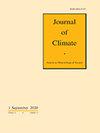全球变暖背景下CESM1大集合水文变化的诊断机制
IF 4.8
2区 地球科学
Q1 METEOROLOGY & ATMOSPHERIC SCIENCES
引用次数: 0
摘要
预计全球变暖将导致降水减去蒸发(P−E)的格局发生重大变化,蒸发(P−E)表示从大气到地表的净通量,或等价地表示大气内水汽输送的辐合。在大多数全球气候模式模拟中,P−E变化的模式类似于历史模式的放大——一种被称为“湿越湿,干越干”的趋势。然而,模型也预测了与这个近似值的显著偏离,这一点尚未得到很好的理解。本文介绍了一种新的方法,将P−E变化模式分解为各种动力和热力学机制的贡献,并利用它来研究CESM1大集合中P−E对全球变暖的响应。与以往的P−E变化分解不同,我们的分解不仅考虑了大气风和湿度的月平均变化,而且考虑了它们的时间变率,使我们能够分离平均环流、瞬态涡流、相对湿度和温度时空分布变化的水文影响。总的来说,我们发现平均环流的变化主要控制了热带地区的P - E响应,而温度变化在高纬度地区占主导地位。虽然具体机制的相对重要性因区域而异,但在全球尺度上,陆地上偏离“湿变湿”近似主要是由于温度递减率的变化,而平均环流、相对湿度和水平温度梯度的变化起次要作用。本文章由计算机程序翻译,如有差异,请以英文原文为准。
Diagnosing mechanisms of hydrologic change under global warming in the CESM1 Large Ensemble
Global warming is expected to cause significant changes in the pattern of precipitation minus evaporation (P − E), which represents the net flux of water from the atmosphere to the surface or, equivalently, the convergence of moisture transport within the atmosphere. In most global climate model simulations, the pattern of P − E change resembles an amplification of the historical pattern—a tendency known as “wet gets wetter, dry gets drier”. However, models also predict significant departures from this approximation that are not well understood. Here, we introduce a new method of decomposing the pattern of P − E change into contributions from various dynamic and thermodynamic mechanisms, and use it to investigate the response of P − E to global warming within the CESM1 Large Ensemble. In contrast to previous decompositions of P − E change, ours incorporates changes not only in the monthly means of atmospheric winds and moisture, but also in their temporal variability, allowing us to isolate the hydrologic impacts of changes in the mean circulation, transient eddies, relative humidity, and the spatial and temporal distributions of temperature. In general, we find that changes in the mean circulation primarily control the P − E response in the tropics, while temperature changes dominate at higher latitudes. Although the relative importance of specific mechanisms varies by region, at the global scale departures from the wet-gets-wetter approximation over land are primarily due to changes in the temperature lapse rate, while changes in the mean circulation, relative humidity, and horizontal temperature gradients play a secondary role.
求助全文
通过发布文献求助,成功后即可免费获取论文全文。
去求助
来源期刊

Journal of Climate
地学-气象与大气科学
CiteScore
9.30
自引率
14.30%
发文量
490
审稿时长
7.5 months
期刊介绍:
The Journal of Climate (JCLI) (ISSN: 0894-8755; eISSN: 1520-0442) publishes research that advances basic understanding of the dynamics and physics of the climate system on large spatial scales, including variability of the atmosphere, oceans, land surface, and cryosphere; past, present, and projected future changes in the climate system; and climate simulation and prediction.
 求助内容:
求助内容: 应助结果提醒方式:
应助结果提醒方式:


